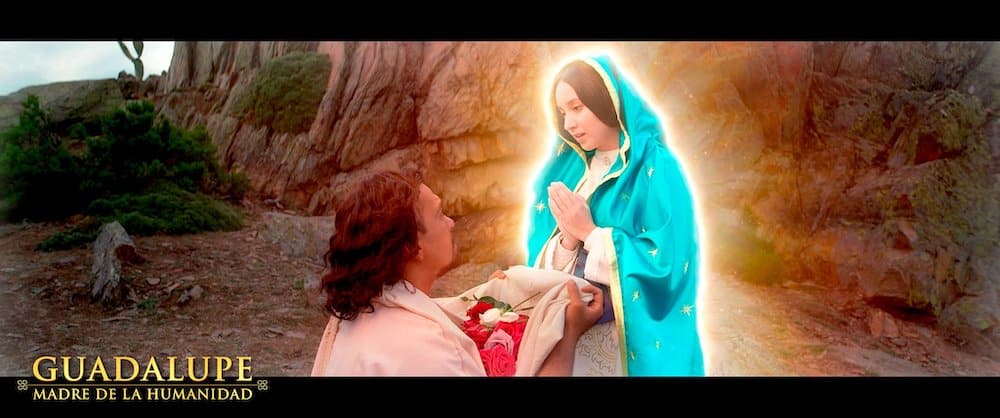(OSV News) — “Guadalupe: Mother of Humanity,” a documentary by Goya Producciones, opens in the United States on Feb. 22. Its director, Andrés Garrigó, talked with OSV News about the film.
This documentary features scenes recreating the apparitions of Our Lady of Guadalupe to St. Juan Diego in 1531. “The world would not be what it is now without the Virgin of Guadalupe,” said Garrigó, speaking of the impact of the mother of God’s apparitions on Tepeyac Hill near what is now Mexico City. “The Virgin arrived, and there were impressive effects and millions of conversions, all thanks to her.”
The film also includes reflections by priests, analysis by historians and scientists, and testimonies of many of the faithful on whom the “Morenita del Tepeyac” has worked miracles. “Former drug addicts, gang members, drug traffickers and underworld people who at one point had contact with the Virgin and became Marian and Guadalupanos and now go around singing, preaching and praising the Lord,” said the director and producer of the documentary.
The testimonies compiled in this production were recorded in Mexico, the United States, Spain and Germany, and they are experiences that transformed the lives of men and women who have received miracles from Our Lady of Guadalupe and who shared her message with others.

Portraying the apparition
“There is no other (Marian) advocation that has so many millions of faithful who come to visit her from far and near with such fervor year after year for (almost) five centuries,” said Garrigó.
The actors who star in this film are of Mexican origin. Angelica Chong plays the Virgin of Guadalupe, and Mario Alberto Hernandez plays St. Juan Diego.
For Garrigó, those who go to the theaters to see the film “will feel like actors and actresses of the apparitions themselves, because we have tried to put such care and affection that I don’t think there is another film or documentary production that is so close to the original ‘Nican Mopohua,'” he said, referring to the oldest account of the story of the apparitions of the Virgin of Guadalupe in Tepeyac to St. Juan Diego, written in Nahuatl.
The devotion to the Blessed Virgin of Guadalupe has reached all continents and that is why for the filmmakers, it is particularly important to know the details of its origin, the historical context that was lived in Mexico in 1531, almost four decades after the discovery of America; and how this devotion has transcended geographical, cultural and linguistic barriers.
“Guadalupe: Mother of Humanity” is a film that not only moves and renews our faith but also addresses with scientific backing those mysteries and messages immortalized in the “ayate,” cloak of St. Juan Diego,which has inexplicably survived almost 500 years.
Gárrigo spoke of the mysteries in the cloak, or tilma, where the Virgin’s image appeared and how the documentary shows the messages for the Indigenous people of that time and the “secrets to be discovered when technology would allow it in the 20th and 21st century.” This includes the images that are reflected in the eyes of Guadalupe, the constellations of stars and “how the cloth has resisted all types of aggressions with dynamite and acid.”

Small miracles
Garrigó commented that for almost two years, the Goya Producciones team worked on the pre-production, shooting and post-production of this film, which also will be released in countries such as Mexico, Central and South America, and Spain.
The film includes an interview with Archbishop José H. Gomez. of Los Angeles. Several scenes were filmed at the Cathedral of Our Lady of the Angels in Los Angeles, as well as a Mass and procession in honor of the “Virgen Morena” celebrated in East Los Angeles. Spanish filmmaker Pablo Moreno is co-director of the documentary, which features Mexican actress Karyme Lozano as host and EWTN anchor Pepe Alonso as narrator.
Garrigó said that finding an actress who would convey an image of purity proper to the Blessed Virgin was a great challenge; however, the first of the four actresses at the casting call was the one who met the requirements, including candor, sympathy and physical similarities.
“She told us that she was a Guadalupana and that her mother was praying for her at that moment of the casting. In the end, it seemed to us like a gift from the Virgin,” recalled Garrigó.
Another early fruit of this film was that one of the writers discovered his call to the priesthood and is now in the seminary, he said.
“We have several miracles, small and large, that happened while shooting,” he recounted. One of them was the scene of the first apparition where, according to forecasts, it would rain heavily. However, the sky cleared, the sun came out, and they managed to film this scene for three hours. After finishing, the sky darkened, and it began to rain.
“Guadalupe: Mother of Humanity” will be shown in select theaters in the United States from Feb. 22 to Feb. 28. The documentary is in Spanish with English subtitles..





